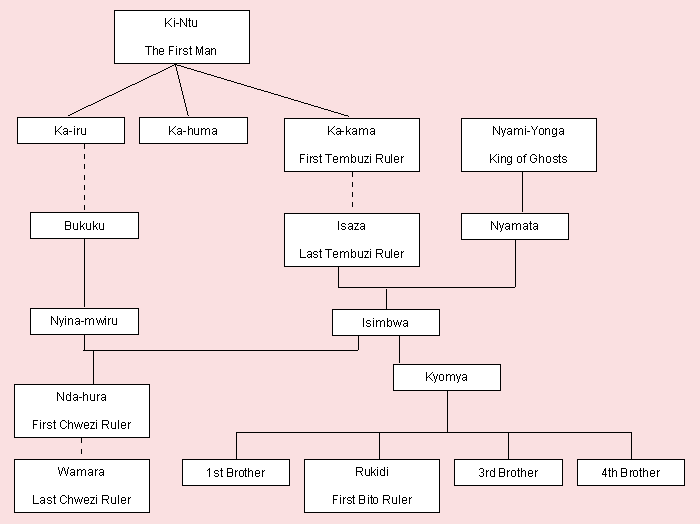
Content created: 2007-07-13
File last modified:
Go to Previous file, Next file, Intro & Outline.
We turn now to four rather complex Nyoro stories which, taken together, provide a rationale for the existence and functioning of Nyoro absolute monarchy. They are a small subset of Nyoro stories, and the retelling does no justice to the elaboration or the artistry of the tales as recounted by the Nyoro themselves. But they will provide us with at least a hint of the way in which myth is used in politics.
5 This is the first of several stories to be analyzed here, all of which circulate in many versions. Although they are retold here as stories, much as a storyteller might recount them; they are not direct quotations.
When the first man was created by God, there were no names, and so he was simply called Ki-ntu, which means “created thing.” He had three sons, and it was confusing for them not to have names, so he asked God if they could be given names. God consented, but to select the names the boys underwent two tests. For the first test, the following items were placed along the path where the boys would find them:
When they found these things on the path, the oldest boy picked up the bundle of food and began to eat. And then, when he was full, he carried away the rest of the food, using the grass head ring. He also took the ax and the knife. That left only the ox head and the leather thong.
The second son took the leather thong, and the youngest took the ox head. but nobody told them what these choices meant.
For the second test, each of the boys had to sit all night on the ground with his legs stretched out in front of him, holding a pot of milk on his lap, and not spilling even a drop. By midnight the youngest of the boys had become very sleepy, and as his head began to bob he spilled a little of his milk, which fell on his leg and woke him up. He begged his brothers for a little of theirs, and each of them gave him a few drops, which were enough to fill his pot back up.
Then as the sky was just growing light, the oldest brother spilled his whole pot of milk. Like the youngest brother, he asked the others for some of theirs, but they refused him, for the amount of milk involved was enough that they would never be able to pass off what was left as a full pot.
When their father Ki-ntu came back in the morning, he found the three boys with their pots. The youngest son had a full pot. The second had a pot that was almost full. But the oldest son had no milk left.
And so, based on these two tests that had been proposed by God, Father Ki-ntu gave his sons names.
The oldest son was named Ka-iru, which means “little peasant” for he had shown that he knew nothing about the value of cattle or milk. He had spilled all his milk, and he had chosen potatoes and millet. He and all his descendants forever would be farmers and servants.
The second son received the name Ka-huma, which means “little herder.” This is because he had chosen the leather thong, used for tying up cattle. And although some of his milk was missing, it was because he had helped his younger brother.
The youngest son of course had all his milk, although it was because his brothers had given him some. This showed that he valued cattle and milk. And he had the head of an ox, although it was because it was all that was left. This showed that he possessed the ability to be head of all the people in the world. And so Father Ki-ntu called him Ka-kama, which means “little mukama.” A mukama is a ruler. Father Ki-ntu declared that Ka-kama was to be his heir, and that Ka-kama and his descendants were to become the kings of the Nyoro forever. He told his sons Ka-iru and Ka-huma to support Ka-kama and serve him, and he instructed Ka-kama to take care of Ka-iru and Ka-huma and to rule them wisely. And this was the beginning of a dynasty of Ka-kama and his descendants, a dynasty called Tembuzi.

What this myth teaches is that it is natural for the descendants of the two older sons to be subordinate to the descendants of the “little ruler.” The differentiation of ruler and ruled is represented as originating in the decisions made by the first man, based on his instructions from God. Hierarchy, with the descendants of Ka-kama on top, is, in other words, the God-given natural order of things.
Beattie noticed some deeper messages as well, as he discussed this myth with his Nyoro informants. For example the myth represents the world before the boys had names, and when they were equal, which was confusing and unmanageable. Social order depended upon their being differentiated, and differentiation did not just mean names, it meant social hierarchy.
Beattie’s informants regarded social hierarchy as necessary to orderly social life. And he observed that “Subordinates may find subordination less irksome, and superordinates may rule more calmly and confidently, when everyone acknowledges the difference between them and the divine origin of that difference” (Beattie 1960: 12).
This was not the only myth that seemed to provide a charter for the power structure of Nyoro society. Story Two is another one.
Go to Previous file, Next file.
Return to Intro & Outline, top of page.